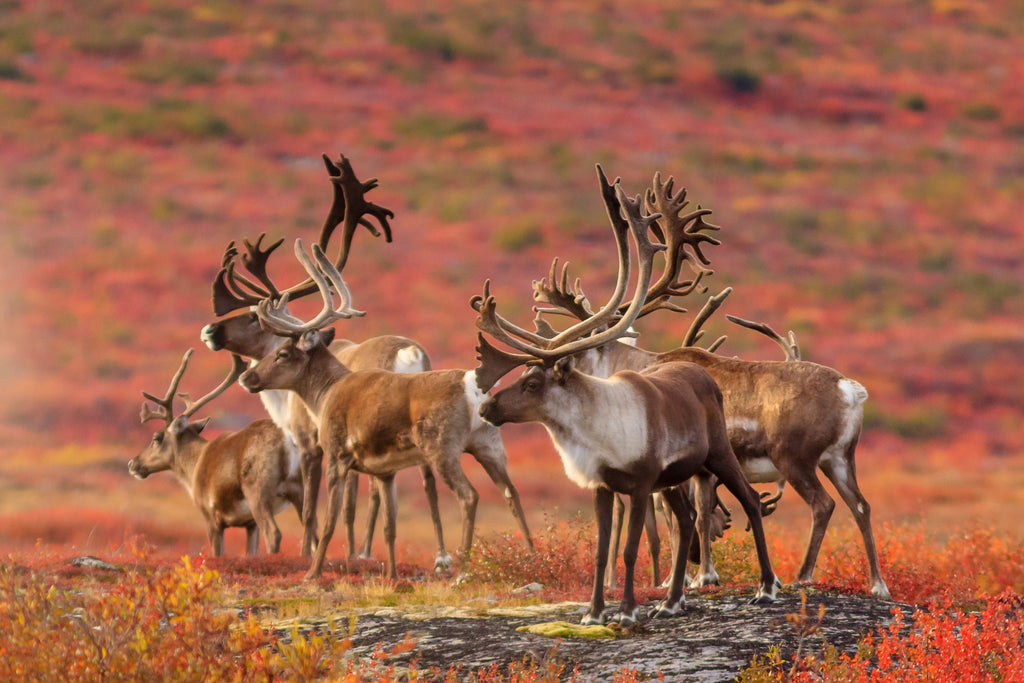Antlers vs. Horns: What’s the Difference?

The terms antlers and horns are sometimes used interchangeably.
Yes, they have similarities. They both grow from an animal's forehead, and they are both used to assert dominance, provide defense, and attract mates. But there are key differences as well.
This article will discuss the distinction between antlers and horns.
Growth
Antlers are exclusive to male cervids, which encompass animals like deer, caribou, elk, and moose.
One striking characteristic of antlers is their annual cycle of growth, shedding, and regrowth.
Each year, antlers grow to different sizes and sport a branched structure. They are considered the fastest growing mammalian appendage, with some species capable of growing up to an inch per day.

Antlers reach their full size during the mating season and are shed or broken off after mating. Subsequently, a new set of antlers grows in next season.
Horns, in contrast, are found in members of the Bovidae family, which includes animals like cows, antelope, goats, water buffalo, and other cloven-hoofed creatures.
Both male and female animals within certain species can develop horns. And unlike antlers, horns exhibit slow, continuous growth throughout an animal's life once they have fully developed. In other words, horns are permanent while antlers are not. They begin growing from the moment the animal is conceived and continue to grow until its death.
Generally, older animals tend to have longer horns. If a horn is damaged or broken, it has the ability to regrow over time.

Material
The biggest difference between antlers and horns is their material.
Antlers are primarily composed of bone. However, they have an extraordinary composition as they form. When they grow, they are covered with a kind of skin tissue called velvet. This soft, spongy layer contains blood vessels, nerves, and hair follicles. At this stage, the entire antler is known as antler velvet.

The velvet provides essential nutrients including growth factors and oxygen to the growing antlers. This is what makes deer antler velvet a nutrient rich dietary supplement - its unique chemical composition.
As the antlers approach their full size, the blood flow decreases, and the antler begins to calcify. This results in the velvet being shed, revealing the hardened bone structure underneath.
Horns are predominantly composed of keratin, the same material found in our fingernails and hair. They consist of a bony core covered by a layer of keratinized skin, which gives them their characteristic hard and polished exterior. A horn’s core consists of live bone while fully grown, hard antler consists of dead bone.
Unlike antlers, horns do not possess velvet. Instead, they grow continuously from the base throughout the animal's life.
Shape

Antlers typically take on a branch-like or tine-like structure.
The exact shape and complexity of antlers vary across species. In some species, such as reindeer, antlers can exhibit intricate branches with a large span.
The size and shape of antlers can also indicate the age and health of the animal. Younger males usually have smaller and simpler antlers, while older and more dominant males tend to have larger and more complex antlers.
Horns come in various shapes and forms.
Some horns are straight and pointed, while others curve or spiral. Certain species, like the pronghorn antelope, have branched horns that add another level of complexity.

The shape of horns can be influenced by genetics, age, and environmental factors. Horns play a crucial role in species recognition and can be used as a visual display of strength and dominance.
Purpose
Antlers serve primarily as a tool for breeding rights and mating purposes.
Male deer engage in the rutting season, typically occurring in late summer and fall, during which they compete to establish dominance and secure breeding privileges.
Antlers are crucial in these sparring matches, where the males clash and push against each other. However, once the mating season is over, antlers lose their purpose and are shed or broken off.

The annual regrowth of antlers allows deer to potentially grow larger antlers in subsequent years, which can contribute to their dominance in future breeding seasons.
Horns are also used to display strength, dominance, and force.
However, unlike antlers, horns serve purposes beyond just breeding rights. Since horns are present throughout an animal's life, they play a significant role in territorial battles and defense against predators.
Horns are utilized for fighting among individuals of the same species, establishing dominance within a herd, and defending resources such as food, water, and territory.

Conclusion
In conculsion, antlers and horns are distinct features found in different animal families.
- Antlers are exclusive to male cervids and undergo an annual growth cycle, while horns can be found in both male and female members of the Bovidae family and grow continuously throughout an animal's life.
- Antlers are composed of bone with a velvet covering, while horns are primarily made of keratin.
- Antlers serve mainly as a tool for breeding rights, whereas horns have broader purposes, including territorial defense.
- The shape of antlers often branches out, while horns exhibit diverse shapes and forms.
Understanding these differences enhances our appreciation for the remarkable diversity and adaptations in the animal kingdom.
CLICK HERE TO BUY ANTLER FARMS® DEER ANTLER VELVET CAPSULES
CLICK HERE TO BUY ANTLER FARMS® DEER ANTLER VELVET EXTRACT LIQUID
CLICK HERE TO BUY ANTLER FARMS® DEER ANTLER VELVET EXTRACT TABLETS
Read more about deer antler velvet.
